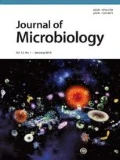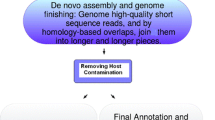Abstract
Brucella species are facultative intracellular pathogenic α-Proteobacteria that can cause brucellosis in humans and domestic animals. The clinical and veterinary importance of the bacteria has led to well established studies on the molecular mechanisms of Brucella infection of host organisms. However, to date, no genome-wide study has scanned for genes related to the host specificity of Brucella spp. The majority of bacterial genes related to specific environmental adaptations such as host specificity are well-known to have evolved under positive selection pressure. We thus detected signals of positive selection for individual orthologous genes among Brucella genomes and identified genes related to host specificity. We first determined orthologous sets from seven completely sequenced Brucella genomes using the Reciprocal Best Hits (RBH). A maximum likelihood analysis based on the branch-site test was accomplished to examine the presence of positive selection signals, which was subsequently confirmed by phylogenetic analysis. Consequently, 12 out of 2,033 orthologous genes were positively selected by specific Brucella lineages, each of which belongs to a particular animal host. Extensive literature reviews revealed that half of these computationally identified genes are indeed involved in Brucella host specificity. We expect that this genome-wide approach based on positive selection may be reliably used to screen for genes related to environmental adaptation of a particular species and that it will provide a set of appropriate candidate genes.
Similar content being viewed by others
References
Benjamini, Y. and Y. Hochberg. 1995. Controlling the false discovery rate: a practical and powerful approach to multiple testing. Journal of the Royal Statistical Society, Series B (Methodological). 57, 289–300.
Bohlin, J., L. Snipen, A. Cloeckaert, K. Lagesen, D. Ussery, A.B. Kristoffersen, and J. Godfroid. 2010. Genomic comparisons of Brucella spp. and closely related bacteria using base compositional and proteome based methods. BMC Evol. Biol. 10, 249.
Boschiroli, M.L., V. Foulongne, and D. O’Callaghan. 2001. Brucellosis: a worldwide zoonosis. Curr. Opin. Microbiol. 4, 58–64.
Castresana, J. 2000. Selection of conserved blocks from multiple alignments for their use in phylogenetic analysis. Mol. Biol. Evol. 17, 540–552.
Chain, P.S.G., D.J. Comerci, M.E. Tolmasky, F.W. Larimer, S.A. Malfatti, L.M. Vergez, F. Aguero, M.L. Land, R.A. Ugalde, and E. Garcia. 2005. Whole-genome analyses of speciation events in pathogenic Brucellae. Infect. Immun. 73, 8353–8361.
Delrue, R.M., P. Lestrate, A. Tibor, J.J. Letesson, and X.D. Bolle. 2004. Brucella pathogenesis, genes identified from random large-scale screens. FEMS Micriobiol. Lett. 231, 1–12.
Delvecchio, V.G., V. Kapatral, R.J. Redkar, G. Patra, C. Mujer, T. Los, N. Ivanova, and et al. 2002. The genome sequence of the facultative intracellular pathogen Brucella melitensis. Proc. Natl. Acad. Sci. USA 99, 443–448.
Dobrindt, U., B. Hochhut, U. Hentschel, and J. Hacker. 2004. Genomic islands in pathogenic and environmental microorganisms. Nat. Rev. Microbiol. 2, 414–424.
Fernandez-Prada, C.M., E.B. Zelazowska, M. Nikolich, T.L. Hadfield, R.M. Roop II, G.L. Robertson, and D.L. Hoover. 2003. Interactions between Brucella melitensis and human phagocytes: bacterial surface O-polysaccharide inhibits phagocytosis, bacterial killing, and subsequent host cell apoptosis. Infect. Immun. 71, 2110–2119.
Fletcher, W. and Z. Yang. 2010. The effect of insertions, deletions, and alignment errors on the branch-site test of positive selection. Mol. Biol. Evol. 27, 2257–2267.
Foster, J.T., S.M. Beckstrom-Sternberg, T. Pearson, J.S. Beckstrom-Sternberg, P.S. Chain, F.F. Roberto, J. Hnath, T. Brettin, and P. Keim. 2009. Whole-genome-based phylogeny and divergence of the genus Brucella. J. Bacteriol. 191, 2864–2870.
Haghjoo, E. and J.E. Galán. 2007. Identification of a transcriptional regulator that controls intracellular gene expression in Salmonella typhi. Mol. Microbiol. 64, 1549–1561.
Halling, S.M., B.D. Peterson-Burch, B.J. Bricker, R.L. Zuerner, Z. Qing, L.L. Li, V. Kapur, D.P. Alt, and S.C. Olsen. 2005. Completion of the genome sequence of Brucella abortus and comparison to the highly similar genomes of Brucella melitensis and Brucella suis. J. Bacteriol. 187, 2715–2726.
Kim, K.M., S. Sung, G. Caetano-Anollés, J.Y. Han, and H. Kim. 2008. An approach of orthology detection from homologous sequences under minimum evolution. Nucleic Acids Res. 36, e110.
Kimura, M. 1983. The Neutral Theory of Molecular Evolution. Cambridge University Press, Cambridge, United Kingdom.
Lavigne, J.P., A.C. Vergunst, G. Bourg, and D. O’Callaghan. 2005. The IncP island in the genome Brucella suis 1330 was acquired by site-specific integration. Infect. Immun. 73, 7779–7783.
Li, W.H., C.I. Wu, and C.C. Luo. 1985. A new method for estimating synonymous and nonsynonymous rates of nucleotide substitution considering the relative likelihood of nucleotide and codon changes. Mol. Biol. Evol. 2, 150–174.
Loytynoja, A. and N. Goldman. 2005. An algorithm for progressive multiple alignment of sequences with insertions. Proc. Natl. Acad. Sci. USA 102, 10557–10562.
Michaux-Charachon, S., E. Jumans-Bilak, A. Allardet-Servent, G. Bourg, M.L. Boschiroli, M. Ramuz, and D. O’Callaghan. 2002. The Brucella genome at the beginning of the post-genomic era. Vet. Microbiol. 90, 581–585.
Moreno, E., A. Cloeckaert, and I. Moriyon. 2002. Brucella evolution and taxonomy. Vet. Microbiol. 90, 209–227.
Moreno-Hagelsieb, G. and K. Latimer. 2008. Choosing BLAST options for better detection of orthologs as reciprocal best hits. Bioinformatics 24, 319–324.
Ohta, T. 1992. The nearly neutral theory of molecular evolution. Ann. Rev. Ecol. Syst. 23, 263–286.
Osterman, B. and I. Moriyon. 2006. International Committee on Systematics of Prokaryotes; Subcommittee on the taxonomy of Brucella: Minutes of the meeting, 17 September 2003, Pamplona, Spain. Int. J. Syst. Evol. Microbiol. 56, 1173–1175.
Pappas, G., N. Akritidis, M. Bosilkovski, and E. Tsianos. 2005. Brucellosis. N. Engl. J. Med. 352, 2325–2336.
Paulsen, I.T., R. Seshadri, K.E. Nelson, J.A. Eisen, J.F. Heidelberg, T.D. Read, R.J. Dodson, and et al. 2002. The Brucella suis genome reveals fundamental similarities between animal and plant pathogens and symbionts. Proc. Natl. Acad. Sci. USA 99, 13148–13153.
Petersen, L., J.P. Bollback, M. Dimmic, M. Hubisz, and R. Nielsen. 2007. Genes under positive selection in Escherichia coli. Genome Res. 17, 1336–1343.
Picardeau, M., D.M. Bulach, C. Bouchier, R.L. Zuerner, N. Zidane, P.J. Wilson, S. Creno, and et al. 2008. Genome sequence of the saprophyte Leptospira biflexa provides insights into the evolution of Leptospira and the pathogenesis of leptospirosis. PLoS ONE 3, e1607.
Porte, F., A. Naroeni, S. Ouahrani-Bettache, and J.P. Liautard. 2003. Role of the Brucella suis lipopolysaccharide O antigen in phagosomal genesis and in inhibition of phagosome-lysosome fusion in murine macrophages. Infect. Immun. 71, 1481–1490.
Rey, M.W., R. Ramaiya, B.A. Nelson, S.D. Brody-Karpin, E.J. Zaretsky, M. Tang, A.L. de Leon, and et al. 2004. Complete genome sequence of the industrial bacterium Bacillus licheniformis and comparisons with closely related Bacillus species. Genome Biol. 5, r77.
Roop II, R.M., J.M. Gaines, E.S. Anderson, C.C. Caswell, and D.W. Martin. 2009. Survival of the fittest: how Brucella strains adapt to their intracellular niche in the host. Med. Microbiol. Immunol. 198, 221–238.
Seleem, M.N., S.M. Boyle, and N. Sriranganathan. 2008. Brucella: a pathogen without classic virulence genes. Vet. Microbiol. 129, 1–14.
Sung, J.M.L., D.H. Lloyd, and J.A. Lindsay. 2008. Staphylococcus aureus host specificity: comparative genomics of human versus animal isolates by multi-strain microarray. Microbiology 154, 1949–1959.
Suyama, M., D. Torrents, and P. Bork. 2006. PAL2NAL: robust conversion of protein sequence alignments into the corresponding codon alignments. Nucleic Acids Res. 34, W609–612.
Tsolis, R.M., R. Seshadri, R.L. Santos, F.J. Sangari, J.M.G. Lobo, M.F. de Jong, Q. Ren, and et al. 2009. Genome degradation in Brucella ovis corresponds with narrowing of its host range and tissue tropism. PLoS ONE 4, e5519.
Vizcaino, N., A. Cloeckaert, J.M. Verger, M. Grayon, and L. Fernandez-Lago. 2000. DNA polymorphism in the genus Brucella. Microbes Infect. 2, 1089–1100.
Waldron, D.E. and J.A. Lindsay. 2006. Sau1: a novel lineage-specific type I restriction-modification system that blocks horizontal gene transfer into Staphylococcus aureus and between S. aureus isolates of different lineages. J. Bacteriol. 188, 5578–5585.
Watarai, M., H.L. Anderws, and R.R. Isberg. 2002. Formation of a fibrous structure on the surface of Legionella pneumophila associated with exposure of DotH and DotO proteins after intracellular growth. Mol. Microbiol. 39, 313–329.
Wattam, A.R., K.P. Williams, E.E. Snyder, N.F. Almeida, M. Shukla, A.W. Dickerman, O.R. Crasta, and et al. 2009. Analysis of ten Brucella genomes reveals evidence for horizontal gene transfer despite a preferred intracellular lifestyle. J. Bacteriol. 191, 3569–3579.
Wong, W.S., Z. Yang, N. Goldman, and R. Nielsen. 2004. Accuracy and power of statistical methods for detecting adaptive evolution in protein coding sequences and for identifying positively selected sites. Genetics 168, 1041–1051.
Yang, Z. 1997. PAML: a program package for phylogenetic analysis by maximum likelihood. Comput. Appl. Biosci. 13, 555–556.
Yang, Z., R. Nielsen, N. Goldman, and A.M.K. Pedersen. 2000. Codon-substitution models for heterogeneous selection pressure at amino acid sites. Genetics 155, 431–449.
Zhang, J., R. Nielsen, and Z. Yang. 2005. Evaluation of an improved branch-site likelihood method for detecting positive selection at the molecular level. Mol. Biol. Evol. 22, 2472–2479.
Author information
Authors and Affiliations
Corresponding author
Rights and permissions
About this article
Cite this article
Kim, K.M., Kim, KW., Sung, S. et al. A genome-wide identification of genes potentially associated with host specificity of Brucella species. J Microbiol. 49, 768–775 (2011). https://doi.org/10.1007/s12275-011-1084-3
Received:
Accepted:
Published:
Issue Date:
DOI: https://doi.org/10.1007/s12275-011-1084-3




